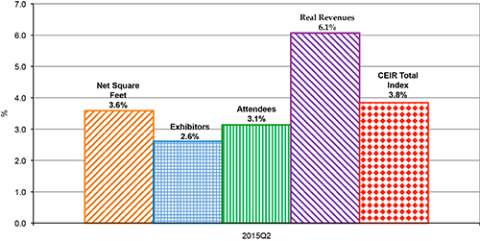Trade Show Industry Snags Highest Quarterly Growth in Eight Years

After a big increase in the first quarter of this year, the performance of the business-to-business trade show industry, as measured by the Center for Exhibition Industry Research’s Total Index, remained relatively strong during the second quarter of 2015, posting a year-on-year gain of 3.8 percent.
This growth is the second highest rate since the second quarter of 2007 and also marked the 20th consecutive quarter of year-on-year growth.
"The second-quarter results are very promising,” said CEIR Economist Allen Shaw, Ph.D., Chief Economist for Global Economic Consulting Associates.
He added, “They show that the exhibition industry is on a solid position for robust growth this year.”
All 14 sectors enjoyed year-on-year gains during the first half of 2015. So far in 2015, the leading sectors have been Building, Construction, Home & Repair (HM), which increased by a whopping 11.8 percent, and Industrial/Heavy Machinery and Finished Business Inputs (ID), which has jumped 10.9 percent.
Conversely, the weakest performing sectors are Raw Materials and Science (RM), gaining by only 0.9%, and Discretionary Consumer Services and Goods (CS), rising a moderate 1.9 percent.
Early this year, the outlooks for Education and Nonprofit (ED) and Government (GV) sectors were pessimistic as tight budgets and sluggish government employment were expected to shrink the potential attendee lists for those exhibitions.
The outlook was especially grim for exhibitions catering to government services, such as military applications.
However, according to the CEIR Index, ED and GV have grown unexpectedly by respectable amounts so far this year.
After several down years, the expansion in these areas may reflect some pent-up demand by state and local employees looking to retool their enterprises.
These stronger than expected gains in ED and GV provide a boost to the overall performance of the exhibition industry.
As an objective measure of the annual performance of the exhibition industry, the CEIR Index measures year-over-year changes in four key metrics to determine overall performance: Net Square Feet of Exhibit Space Sold; Professional Attendance; Number of Exhibiting Companies; and Gross Revenue.
The CEIR Index provides data on exhibition industry performance across 14 key industry sectors: Business Services; Consumer Goods; Discretionary Consumer Goods and Services; Education; Food; Financial, Legal and Real Estate; Government; Building, Construction, Home and Repair; Industrial/Heavy Machinery and Finished Business Outputs; Communications and Information Technology; Medical and Health Care; Raw Materials and Science; Sporting Goods, Travel and Entertainment; and Transportation.
Click here for information on how to purchase the complete CEIR Index Report, which analyzes the 2014 exhibition industry and provides a future outlook for the next three years.
Predict: CEIR's Annual Outlook Conference will be held Sept. 16-17 at the JW Marriott in Chicago, where an expert economist will provide an outlook on the global economy and how the exhibition industry is faring nine months into the year.
Visit www.ceir.org/predict for more details.


Add new comment